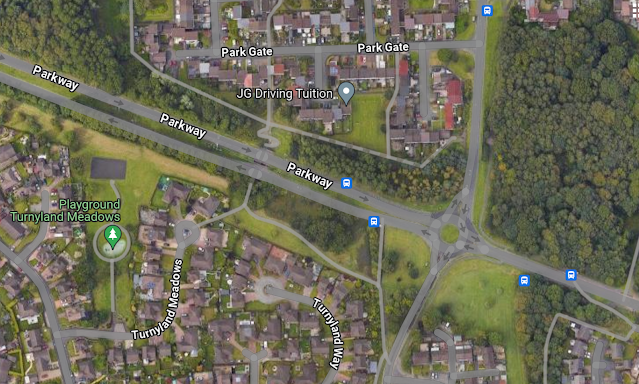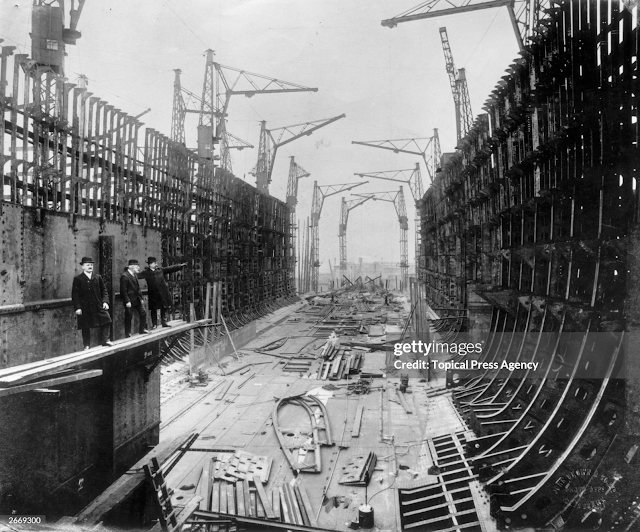James McPhee Campbell
James McPhee Campbell was born on 16th August 1896 at a farm building on the road between Govan and Renfrew. The building was called the Lodge and behind it ran a track lined by trees leading to Braehead Farm.
This 1928 photo shows the digging of the King George V dock but the cottage where James was born is still visible, ringed in red.
This is the same photo but zooming in on the cottage (left) and farm (right). I have written a separate post about the location (click here) but in short, the modern Marks and Spencers Food Hall would be just behind the farm.
James was the first child of John Campbell and Flora McPhee. John was a ploughman and his work took him from farm to farm.
James lived with his family at Gateside Farm, Inchinnan, in 1898 when John was born. Here is the same area today:
Note echoes of the farm names in the street names.
In 1901 the family was at "Old Westerton" when Ronald was born. The 1901 Census lists farms called "Westerton" and "Old Westerton" but the map resolutely refers to "North Westerton", "South Westerton" and "mid Westerton". After consulting this page on the history of Westerton, I think "North Westerton" is the oldest, hence the Campbell's home:
Mid and South Westerton are on the line of today's Maxwell Avenue.
This is a view taken from approximately Stirling Avenue looking north over the newly built rooves of Maxwell Avenue to North Westerton Farm, around 400 yards away.
By the time of the 1911 Census when James was 14 years of age, the family had settled at Mosshead Farm, just north of Bearsden.
This photo is from much later, but shows the position of Mosshead Farm. Schaw House would also have been familiar to James (completed 1893?) but the rest is more modern - Edghill Road on the right, Dryman Road on the left and Bailie Drive and Dumgoyne Drive at the top.
Again, this photo is from the 1950s but gives one of the very few views of the farm we have. I suspect the track in the foreground is on the line of today's Stockiemuir Road. (SEe my post on Mosshead Farm click here.)
James had a job, presumably having left school the previous year and was employed as a messenger for a fruiterers. The most likely local candidate would be Andrew Wilson's florist and fruiterer's shop at 1 Douglas Place.
Of all the problems I have had to untangle in writing the profiles on this website, the naming and numbering of the shops at Bearsden Cross is the most difficult! I suspect that the shops ringed in red were called Douglas Place at the time. My guess is number 1 would be the one nearest the camera (recently the Bank of Scotland).
This job does not seem to have lasted very long as we know that before 1914, James had started as an apprentice at John Brown's shipyard in Clydebank.
This photo is a view of the building of the Acquitania, at John Brown's yard, Clydebank, started 1911, finished 1913.
War broke out in August 1914 and James enlisted on 31st October. While his brother John joined the Argyll and Sutherland Highlanders (1st/9th Battalion) James seems to have joined the Royal Highlanders (Black Watch), the 8th Battalion. They trained in the UK, then were sent to France, landing in Boulogne from Folkstone on 10th May 1915.
The battalion would have had an active time, taking turns in the front line, and then being moved back to rest for a few days. Occasionally they would be involved in an attack, which was the most dangerous time. In July 1916 as part of the Battle of the Somme (which lasted for several months) the battalion attacked at Longueval. There is an excellent short account of the 8th Battalion's experience available, click here; note that after four days of fighting, only 171 men were left so around two-thirds of those who started that battle were killed or wounded (including James).
By April 1917 James had been promoted from private in 1914 to corporal to sergeant; indeed in the first days of that month he was put in charge of a platoon of around 40 men, a job that would usually have been done by a lieutenant and a demonstrrtion of the confidence his commander had in him.
A big attack was planned, the Battle of Arras:
The 8th Black Watch moved up into the line to attack, the British trenches shown in red to the left of the following map and the three objectives marked in black, blue and brown as move from left to right:
On the extreme left the letters C and B in black can be made out - these were the positions of the two companies leading the battalion's attack. Each company had two platoons in the first wave and two in the second wave (one of the pltoons led by James); each platoon was in two waves, each of two sections (about 10-12 men per section).
At 5.30am on the 9th April, the artillery barrage and infantry attack began simultaneously and was a success.
Today the area is on the edge of the small town of Saint-Laurent-Blangy:
The red oval is approximately where 8th Black Watch attacked from heading east towards the first objective, the German first line marked in black.
The full letter to his parents from one of his friends in the battalion was reported in the Milngavie and Bearsden Herald on 4th May 1917:






















Comments
Post a Comment